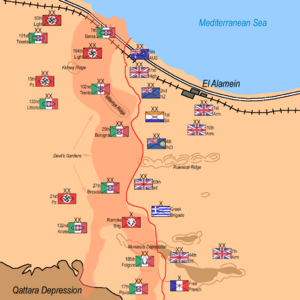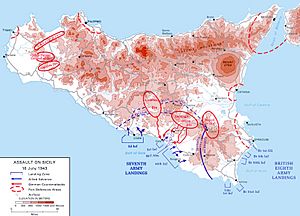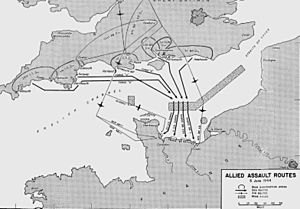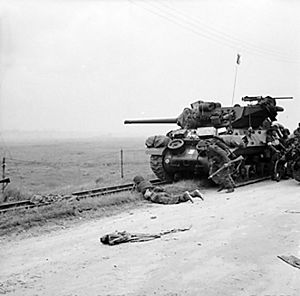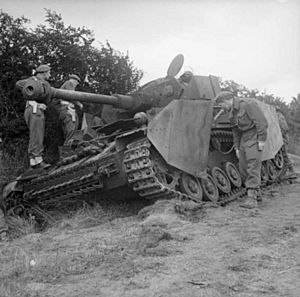151st Infantry Brigade (United Kingdom) facts for kids
Quick facts for kids 151st Infantry Brigade |
|
|---|---|
| Active | 1939–1946 |
| Country | |
| Branch | |
| Type | Infantry |
| Size | Brigade |
| Part of | 50th (Northumbrian) Infantry Division |
| Engagements | Battle of France (1940) Battle of Arras Battle of Gazala Second Battle of El Alamein El Agheila Operation Pugilist Mareth Line Wadi Akarit D-Day Operation Perch Operation Market Garden |
| Commanders | |
| Notable commanders |
Richard Sugden |
The 151st Infantry Brigade was a special group of soldiers in the British Army during World War II. They fought in many important battles across Europe and North Africa. This brigade was part of the 50th (Northumbrian) Infantry Division. Most of its soldiers came from three battalions of the Durham Light Infantry (DLI).
Contents
History of the Brigade
Who was in the Brigade?
The 151st Infantry Brigade was made up of these groups during the war:
- 6th Battalion, Durham Light Infantry
- 8th Battalion, Durham Light Infantry
- 9th Battalion, Durham Light Infantry (until late 1944)
- 1/7th Battalion, Queen's Royal Regiment (West Surrey) (joined in late 1944)
Fighting in France (1940)
In January 1940, the 50th Division, including the 151st Brigade, went to France. They were part of the British Expeditionary Force (BEF). In May 1940, German forces quickly broke through French lines. This cut off the BEF from the main French armies.
The Arras Counterattack
To try and close this gap, British forces launched a counterattack near the city of Arras. This attack was led by just two battalions of the 151st Brigade, the 6th and 8th DLI. They were supported by tanks. The attack surprised the Germans and made good progress before it was stopped. This surprise attack might have helped cause a pause in the German advance. This pause allowed the BEF to start their escape from Dunkirk.
Escaping from Dunkirk
After the Arras attack, the BEF needed to leave France quickly. Most of the 151st Brigade and the 50th Division were lucky enough to be rescued from Dunkirk. However, they had to leave all their equipment behind. When they returned to Britain, the brigade got new soldiers from other regiments. They then prepared to defend Britain from a possible German invasion.
Battles in North Africa
In April 1941, the 50th Division and the 151st Brigade were sent to the Middle East. They served in places like Cyprus, Iraq, Syria, and Egypt. By May 1942, they were fighting in Libya.
The Battle of Gazala
On May 27, 1942, German General Erwin Rommel attacked the Allied forces at Gazala. The 50th Division held the middle of the Allied line. The 151st Brigade faced east and fought off a fake attack by Italian troops. By June 14, Rommel had won a big victory. The Allied army had to leave the Gazala line.
The 50th Division was cut off from the main road. So, their commander, Major-General William Havelock Ramsden, ordered the 151st Brigade to break through the Italian forces. They then circled south before turning east. This amazing plan worked! The 8th Battalion, DLI, led the breakthrough on June 14. Most of the brigade followed. The 9th Battalion, DLI, was cut off but later rejoined them in Egypt.
Mersa Matruh
On June 27, the German 90th Light Division attacked the 151st Brigade. The 9th DLI lost 300 soldiers as prisoners. British forces had to leave the Mersa Matruh area. On July 1, the 50th Division was moved to a reserve position in Egypt.
A Hero: Private Adam Wakenshaw
Adam Herbert Wakenshaw, a 28-year-old soldier in the 9th DLI, showed incredible bravery on June 27, 1942. He was awarded the Victoria Cross, which is the highest award for bravery in the British military.
The Second Battle of El Alamein
In October 1942, the 50th Division prepared for the Second Battle of El Alamein. This was a very important battle in North Africa. The 151st Brigade was later attached to the 2nd New Zealand Division for a new attack called "Operation Supercharge." This attack started on November 2 and was a success. The 151st Brigade helped clear German minefields. After this, they were moved to a reserve position and did not fight further in this battle.
Fighting in Tunisia
By March 1943, the Allied army had pushed the Axis forces (Germany and Italy) across Libya into Tunisia. The Axis forces set up defenses along an old French line called the Mareth Line. The 50th Division, including the 151st Brigade, was part of the first attack on March 19, 1943. After the Mareth Line fell, the Axis forces retreated further north.
The Invasion of Sicily
The 50th Division and the 151st Brigade were part of "Operation Husky." This was the Allied invasion of Sicily. On July 10, the 151st Brigade landed in the Gulf of Noto. Their goal was to capture the hills above the beaches. The brigade fought in eastern Sicily until August 13.
Fighting in Northwest Europe
D-Day: The Normandy Landings
After fighting in Sicily, the 50th Division and the 151st Brigade returned to Britain. They trained for a huge invasion of northwest Europe. This was Operation Overlord, also known as D-Day. The 50th Division was chosen to land on Gold Beach in France. The 151st Brigade was part of the second wave of landings. Their job was to push inland after the beach was secured.
The 151st Brigade landed as planned and reached the edge of Bayeux. They continued to advance. On June 14, the brigade fought in "Operation Perch." They attacked the villages of Lingèvres and Les Verrières. The 9th DLI captured these villages. Later that day, the brigade was cut off but fought off strong German counterattacks before pulling back. The brigade continued to fight in Normandy until the German forces were defeated in August.
Operation Market Garden
The 151st Brigade was part of "Garden." This was the ground part of a big plan called "Operation Market-Garden." This operation aimed to capture bridges in the Netherlands.
On September 23, the 151st Brigade was ordered to move north and east of Eindhoven. Their job was to protect the right side of the advancing forces.
On September 30, the 50th Division was given the task of guarding a bridge and area north of Nijmegen. This area was called "the Island." German forces launched several strong attacks with tanks and soldiers. The 50th Division and the 151st Brigade suffered many losses during these battles.
Becoming a Training Unit
After all this very heavy fighting, the 50th Division and the 151st Brigade were taken out of action. In December, they returned to Britain. They were then changed into training units. This meant they would help train new soldiers instead of fighting in battles.
After the War
In 1947, after the war ended, the 50th (Northumbrian) Division was brought back. The 151st Brigade was also reformed. It was renamed the 151 (Yorkshire & Durham) Infantry Brigade.




